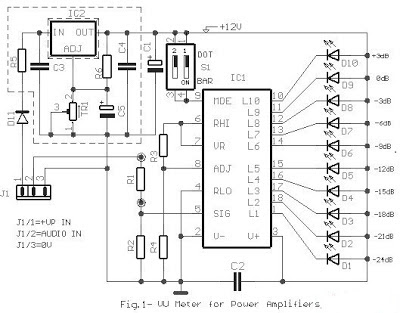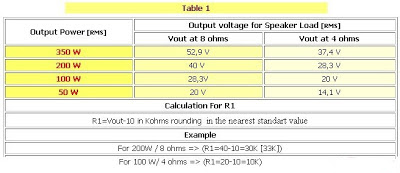Build a 10 LED Bar Dot VU meter circuit based LM3915. It differs in
many respects from other applications on the same chip. The circuit is
intended for those who want a VU meter that is connected directly to the
output of an power amplifier.
10 LED Bar Dot VU Meter Circuit based LM3915 Circuit Diagram
It’s possible to adjust the sensitivity to work with amplifiers that
have different output power, you just need to change the value of R1
according to Table 1. In case you did’n find the exact resistor value,
then choose the next standard value (for example if you cannot find 33K
ohm, then find the 36K ohm), or if you want maximum accuracy you need to
put resistors in series or in parallel to achieve the correct value.
You
can use various types of LEDs (round or square) to get the visual and
aesthetic result you want. The switch S1 will allow you to choose
whether VU meter will work as a bar or one by one (dot). In position ON
[closed switch], the LED operation is Bar, while in position OFF [open
switch], the LED operate in Dot. In Bar mode, the power consumption
rises because all of the LED will be work and can reach up to 150mA.
For
amplifier with two channels is obvious that we should build two
identical circuits, one for each channel. The operating voltage of the
circuit is +12 V. Taking this trend should be done by the tendency of
the amp. Usually amps work with voltages which higher than +12 Volts for
the circuit. For this reason, we must added a component which can
decrease, regulate and stabilize the +Vp voltage at +12 Volts. The
component we are used is IC2 (LM317) which is an adjustable voltage
regulator and stabilizer.
Using a small brushing is necessary
because the differences in the potential entry; output is large so that
we develop high levels of temperature. The use of R5 helps in voltage
drop to descend the voltage at the input of IC2 at lower levels. The
calculation of this resistance is more empirically using Ohm’s law. The
voltage at the input of IC2 must be higher than +16 Volts. For example,
if the voltage of the amplifier is +50 Volts, we should have a voltage
drop 50-16 = 34 Volts on the resistance R5. For the electric current,
50mA average is needed by the circuit [may be up to 150mA], the value of
R5 = V / I = 34/0.05 = 680 ohms 2W. You may need to increase or
decrease this value by trials. Because the resistor is going to heat up,
then it will be better to put some distance from the PCB.
It
will be better to set up and measure the output vltage of the IC2 by
adjusting TR1 first, you need yo remove IC1 to secure the IC1. If you
are able to supply the stabilized +12 V from somewhere in the amplifier
circuit, then you’ll need to remove the R5, the IC2 and materials inside
the dotted line.
PCB layout design:








